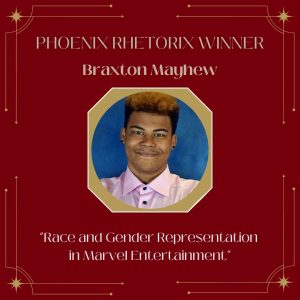- Home
- Academics
- First-Year Writing
- Phoenix Rhetorix
- 2022-23 Journal
- Race and Gender Representation in Marvel Entertainment
Race and Gender Representation in Marvel Entertainment
Race and Gender Representation in Marvel Entertainment
A Video Essay by Braxton Mayhew (he/him)
Author Interview: Braxton Mayhew 
Q. What was your inspiration for writing “Race and Gender Representation in Marvel Entertainment”? Why was this project meaningful to you?
A. My first idea was to write a paper on the history of the video game industry, then it was the history of the movie industry, then the history of race and gender in the movie industry. I couldn’t decide what I wanted to do. I needed a topic that was not too broad, easy to research and write about, and interesting to me. The real passion behind this video essay came from two things: my deep passion for movies, and my long-running desire to disprove the argument that Marvel Entertainment was rooted in racism and misogyny. Movies have been my passion since I was “knee-high to a grasshopper” as my grandma would put it. For the majority of my childhood, Marvel movies were the only movies I went out to the cinema to watch, and they therefore formed the foundation of my love for film. It often upset me when I heard people speak negatively about Marvel and the supposed “misogyny and racism” in the movies. When I was given this assignment in my ENG1100 class, it was the first time in my life that I was given the chance to do an entire research project on whatever I wanted, so I took the chance to research a topic that’s been on my mind and heart since 2010.
Q. Is this your first time working on a video essay? If yes, what did that learning process look like for you? How has it changed the way you’ll work with writing in the future?
A. This was my first time ever creating something in this format. I made a short “documentary” sophomore year of high school for a psychology class but it was far different from this video essay. This assignment took much longer than that one and I put in much more effort. First, I had to find an editing software that was free and easy to use. I ended up going with CapCut for the editing, just because it was the easiest software I could find. This is where the majority of my learning came from. I could have easily finished editing this project in an hour or two, but once I started editing I began learning how to do new things. Learning how to do new things is extremely dangerous for me because I am a big dreamer and love going above and beyond. As I learned how to add images, words, and background music; do effects; split my audio into takes, get rid of noises in the background, etc., all of these things led me to put many additional hours of work into the project. I am proud of the final product, so much so that it made me want to do more video creation.
Q. What is one thing you want Phoenix Rhetorix readers to take away from your piece after watching it?
A. Good change can be done in many ways. If a person wants to do good in the world they do not need to be powerful and rich; they can be a teenage janitor at a failed publishing company. They do not need to create a petition and protest for hours; they can make something new and creative to touch the next generation. The world is a rapidly developing place, and change happens whether we like it or not. If you want to be part of that change, you never have just one black-and-white choice for how you encourage it. You can encourage change through creativity and unconventional means.
Q. In what ways did you have to think outside the box to create this piece?
A. Some people might say that using CapCut to edit my video is a little unorthodox. CapCut is an editing software that is typically used to edit videos for TikTok, videos that are usually only about 60 seconds long. My original video was roughly 16 minutes long and had upwards of 50 images, 10 audio segments, and 6 music files. The software I used was not built for that type of video, and it began to really show once I got a good way into editing. I also thought outside the box in the way I went about the visuals of the video essay. I really did not want to record my face and talk to a camera for the video, so I decided to have different images pop up every few seconds that related specifically to what I was saying in that exact sentence.
Q. What advice would you give to students who are currently enrolled in ENG 1100, might want to complete a similar project, or are interested in publishing in Phoenix Rhetorix?
A. If you want something, just go for it. It’s better to try and fail than to not try at all and wonder what could have happened if you did. There is no point in not trying anything in life: go skydiving, eat squid, ask out your crush, learn to build an android. Life is about experiences and if you’re not trying, you’ve already failed. So go for it.
ENG 1100 Faculty Interview: Heather Lindenman (she/her) 
Q. During your ENG 1100 class, what about Braxton’s piece stood out to you?
A. What stood out most is how meticulous Braxton was about his work. He paid such close attention to detail and revised repeatedly. Braxton created two pieces about Marvel comics in my class: one written and this video. His voice came out in his written work, but it’s fun to actually hear him speak in the video.
Q. How do you see Braxton’s piece contributing to Elon’s ongoing conversations regarding diversity, equity, and inclusion?
A. Braxton’s project considers the ways Marvel comics strategically includes and foregrounds characters of various identity groups. His argument, that Marvel has always included these characters but started to make them more central in recent years, acknowledges how Marvel strategically sidesteps societal biases by “camouflaging” some characters and its commitment to inclusivity.
Q. How did Braxton use creativity when working on this project? Did he try anything you’ve never seen before?
A. Braxton decided to create this the way he did despite having never made a video essay before. It was all his idea–the structure, design, argument, images, voice–all of it. It was so fun to watch a mind at work as Braxton put this together.
Q. What stood out to you about the author’s work on this project or their approach to the project?
A. Braxton’s essay on this topic was easily three times the length of everyone else’s in the class. He got into the research process, went down several rabbit holes, and immersed himself. When he transformed his written work into this video format, he spent many hours reformulating the ideas and approach. He must have revised and edited dozens of times. I loved working with Braxton on this project because of his vision, motivation, good humor, and intellectual approach to everything.